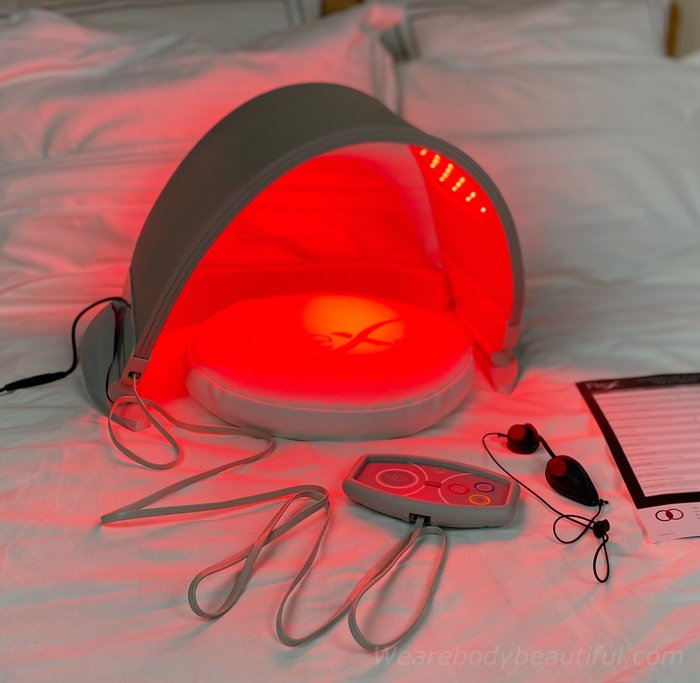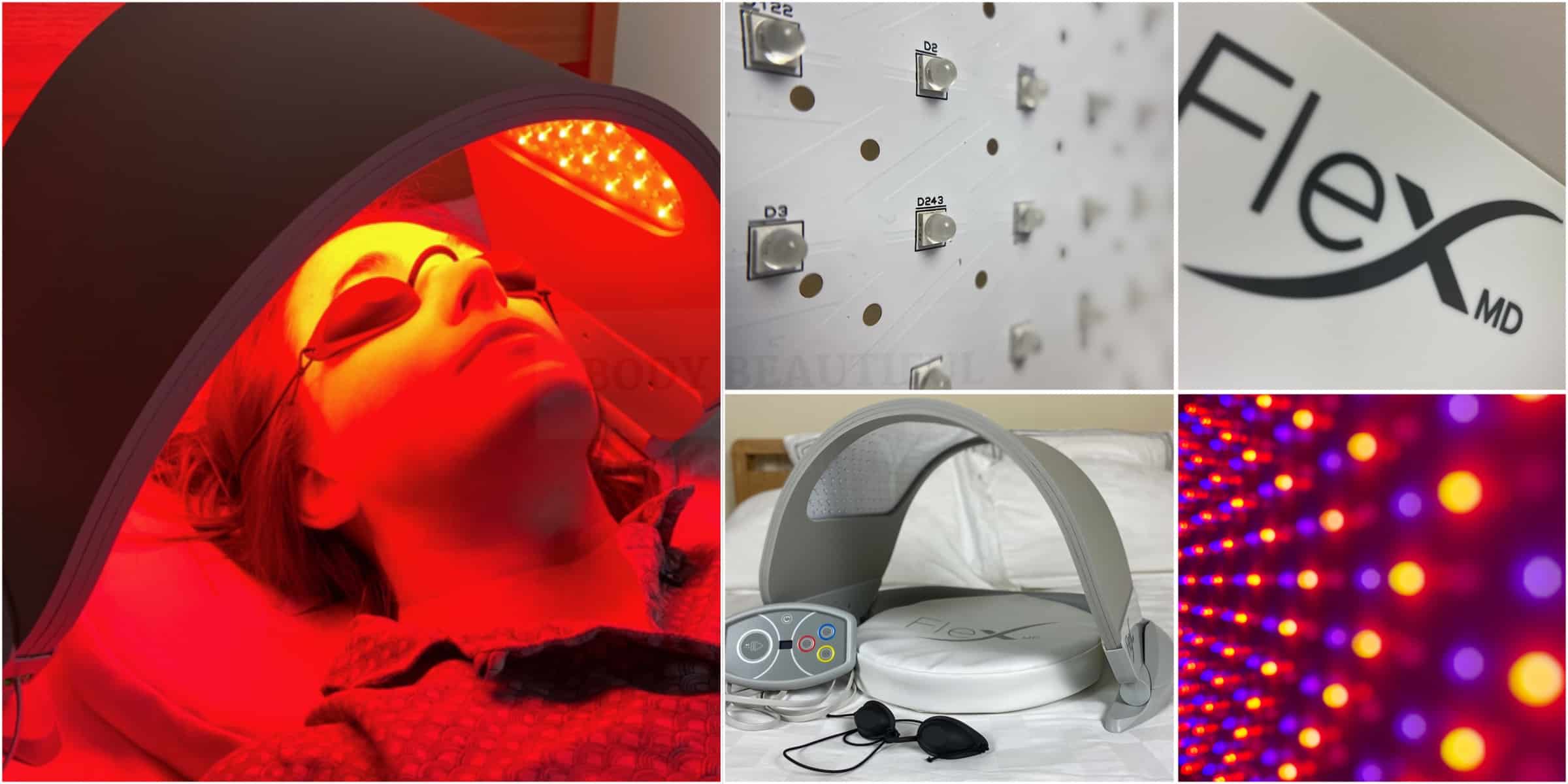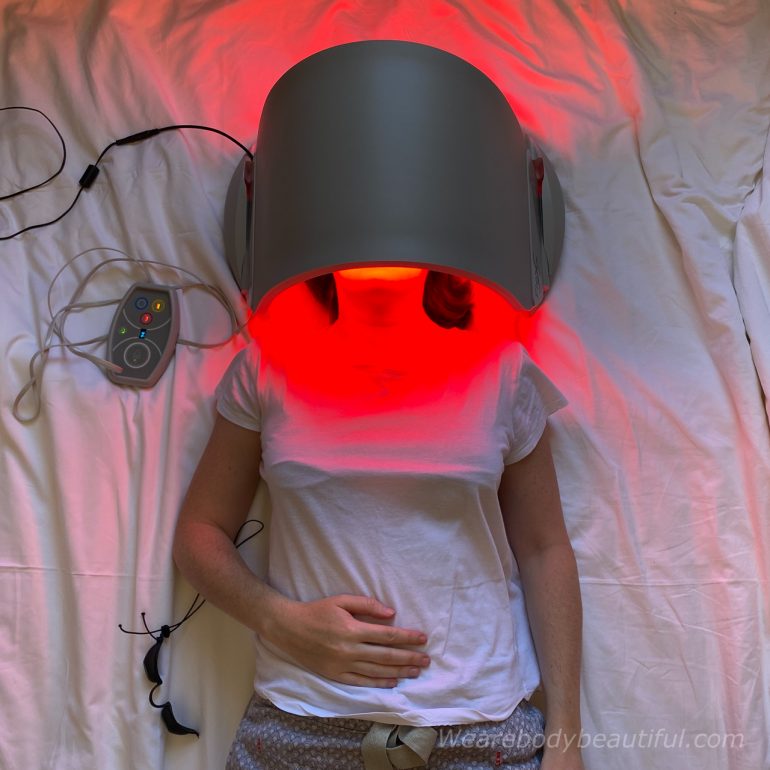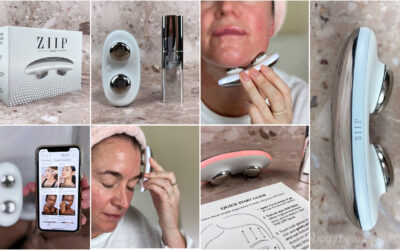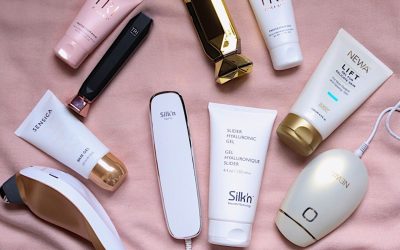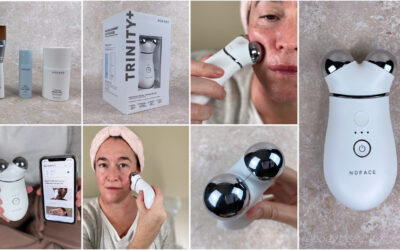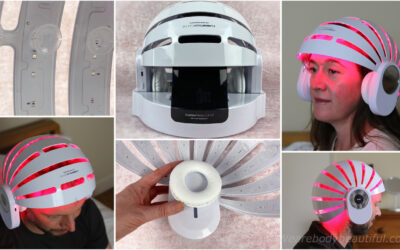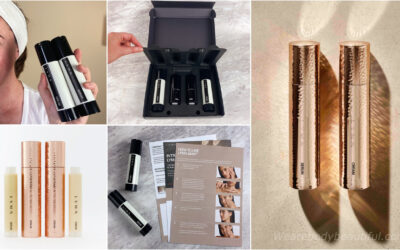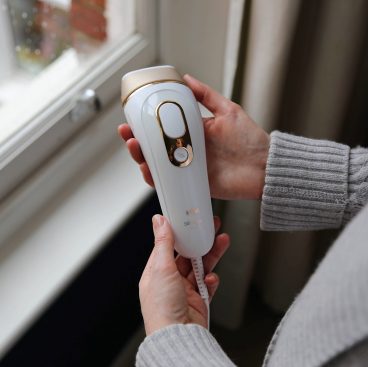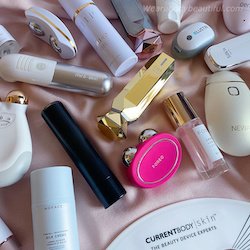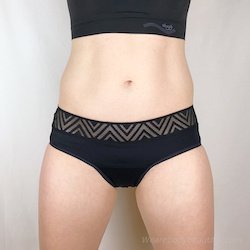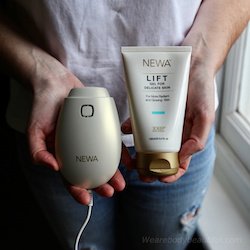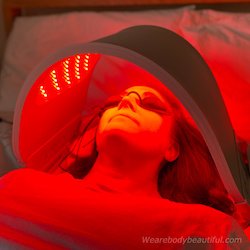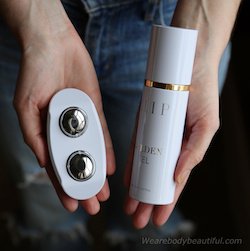What is it?
The Flex MD is a large, bendy LED panel made by experts Dermalux. It’s for both in-clinic treatments and for the LED aficionado to use at-home.
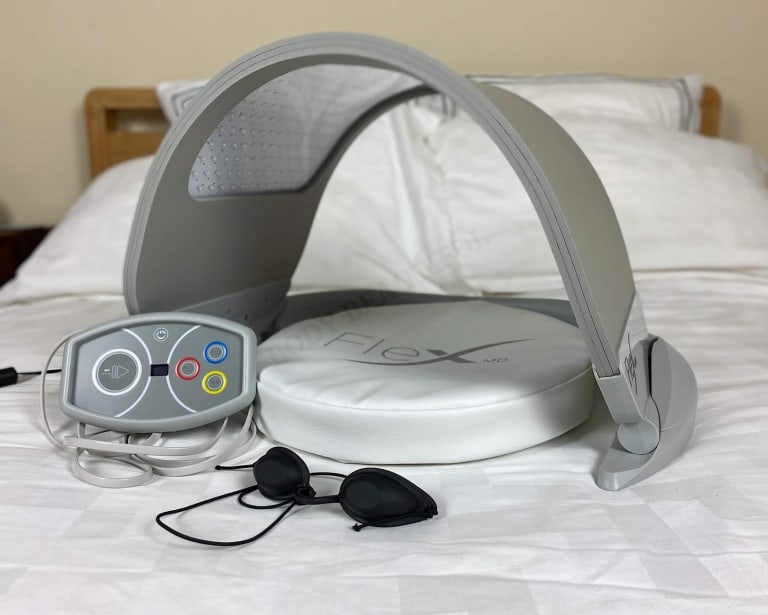
An imprressive multi-tasker for treating mild, moderate & severe acne, bacterial conditions, psoriasis, hormonal pigmentation, inflammation & redness, wound & scar healing, sensitive & delicate skin, skin rejuvenation, dark spots, wrinkles, loads more signs of aging, & pain relief. Use the canopy around your head, face and neck, or lay it flat against your skin on other body areas.
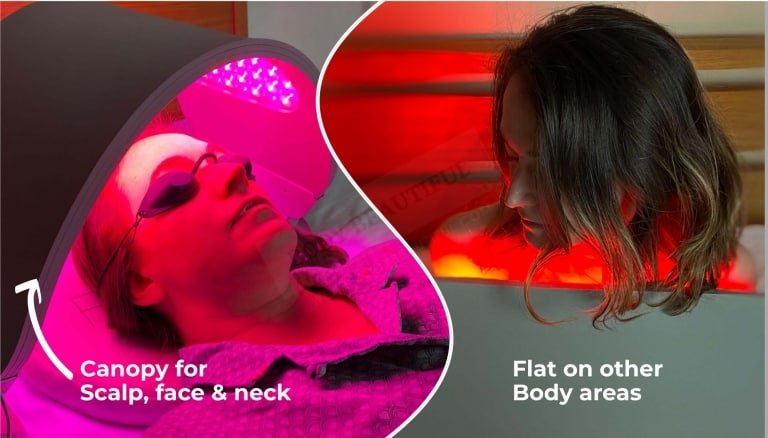
Dermalux tech is proven to kick-start significant biochemical changes in our skin. So much so, it’s the only home device CE medically certified to treat acne, heal wounds, psoriasis and relive pain. Therefore, it’s extra fast and effective versus rival home LED devices for anti-aging concerns too!
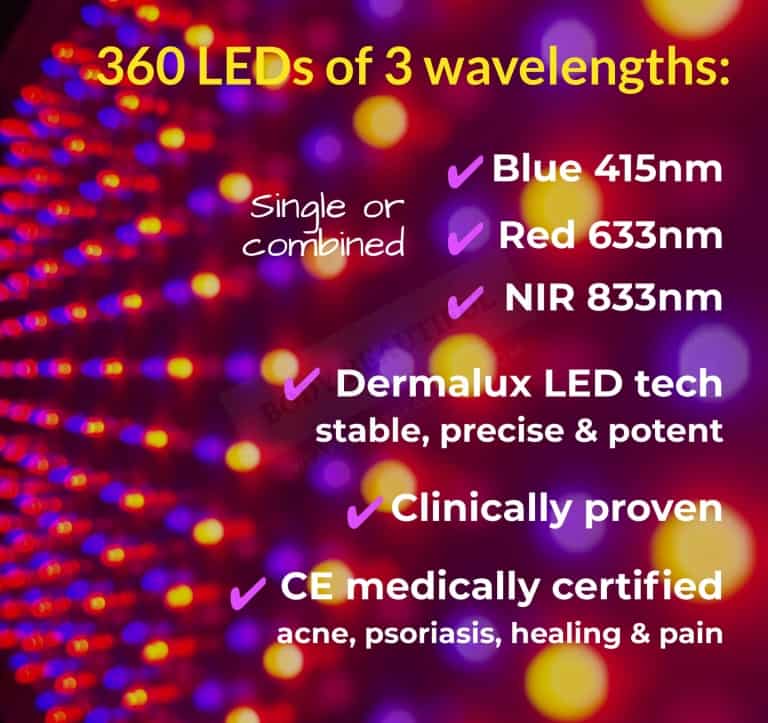
DERMALUX CLAIMS:
Dermalux make some very impressive claims about the Flex MD.
👉 It uses unique LED technology
👉 Dermalux say it’s the World’s most powerful home LED device
👉 It gives professional-level results
If you want to know if these claims are true, then you’re in luck. I fact-check them in the review below 🤓.
With the Flex MD you can use single or combined wavelengths. The photons in these specific light wavelengths do special things in your cells with a process called photobiomodulation.
The red (633nm) and NIR (830nm) wavelengths reach different depths where they reduce inflammation, boost blood flow, and energise all your cells, kickstarting collagen and elastin production, to calm, heal, refresh, hydrate and brighten your skin. And they build gentle heat to relieve muscular and joint pain too.
Blue wavelength (415nm) controls sebum, destroys acne and other bacteria, and calms other bacterial conditions for improved skin clarity.
First impressions
The Flex MD wins first place 🥇 for home beauty device in impressively large packaging. Everything is nice and secure in recyclable cardboard, so there’s very little wasteful, plastic packaging ♻.
It takes a while to unpack the several layers of cardboard packaging. You’ll need a small knife or box cutter to slice through the tape and seals (take care not to damage the kit). This not only prolongs the suspense but it’s also the most expensive game of pass the parcel I’ve ever played! By myself, admittedly.
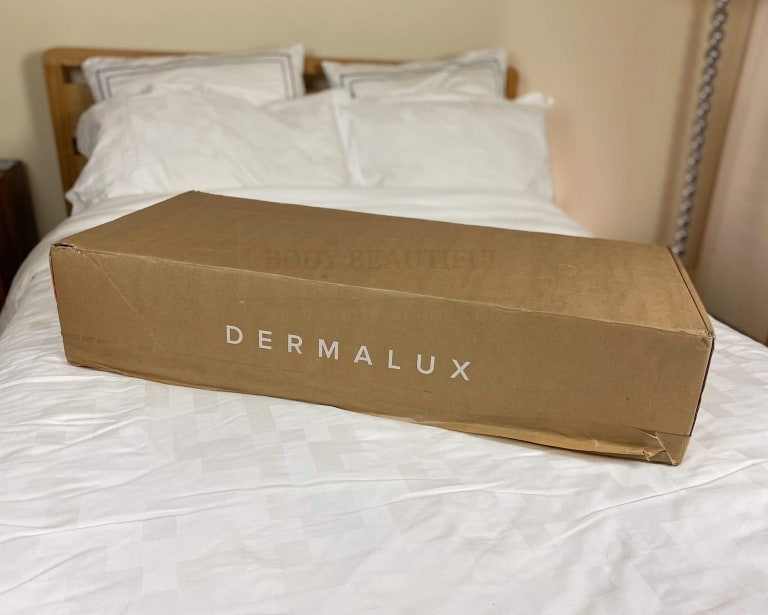
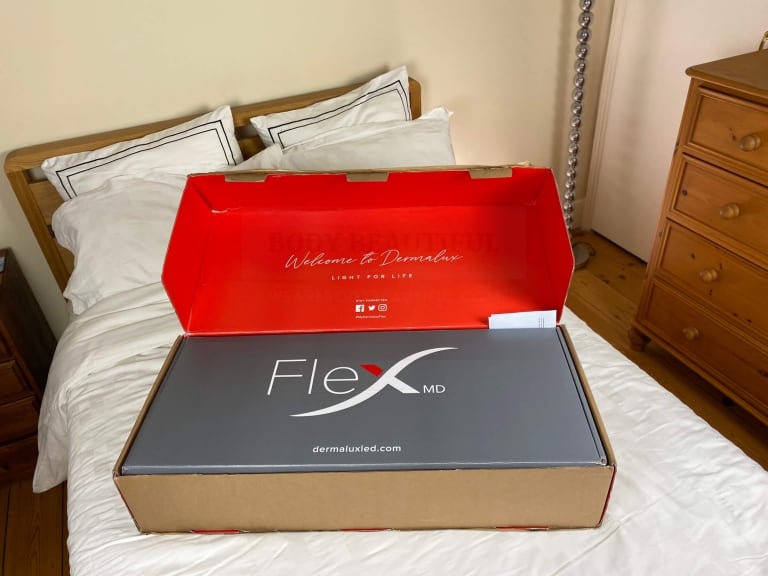
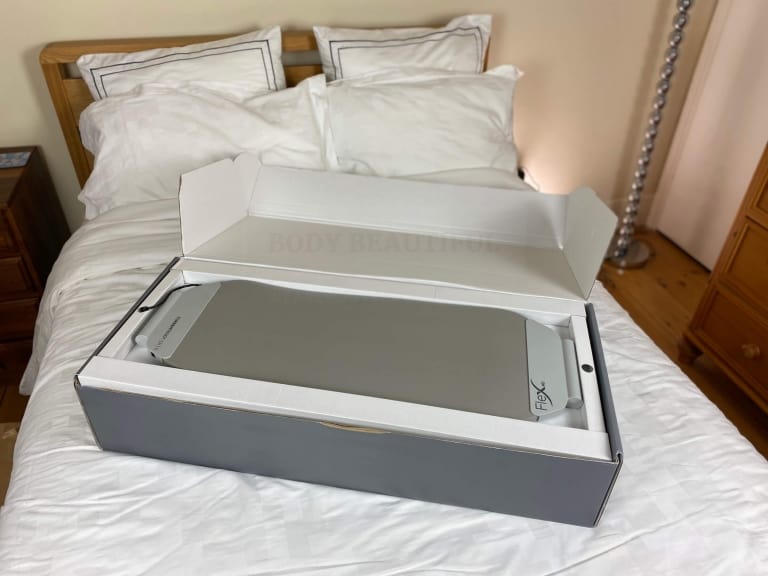
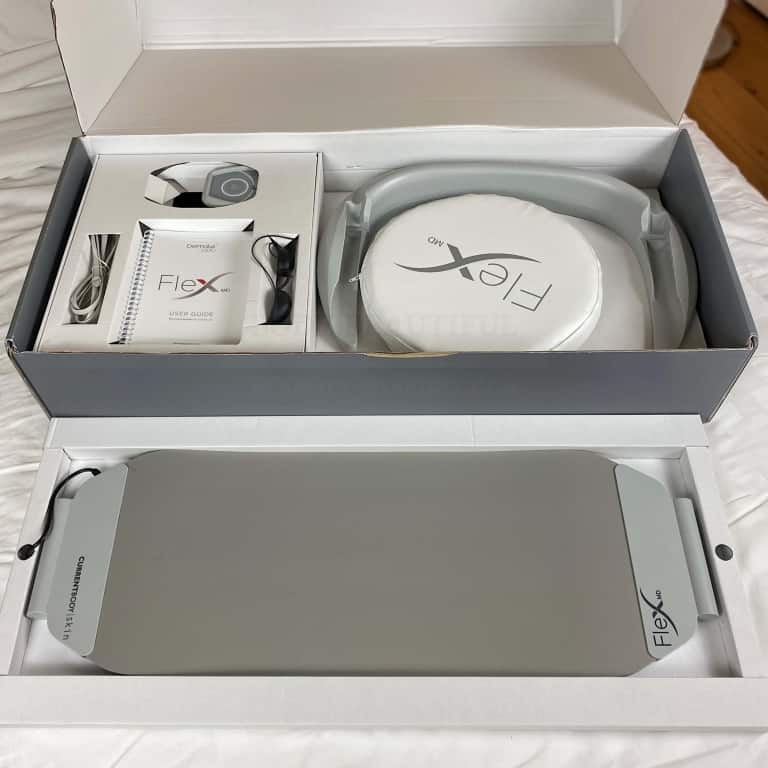
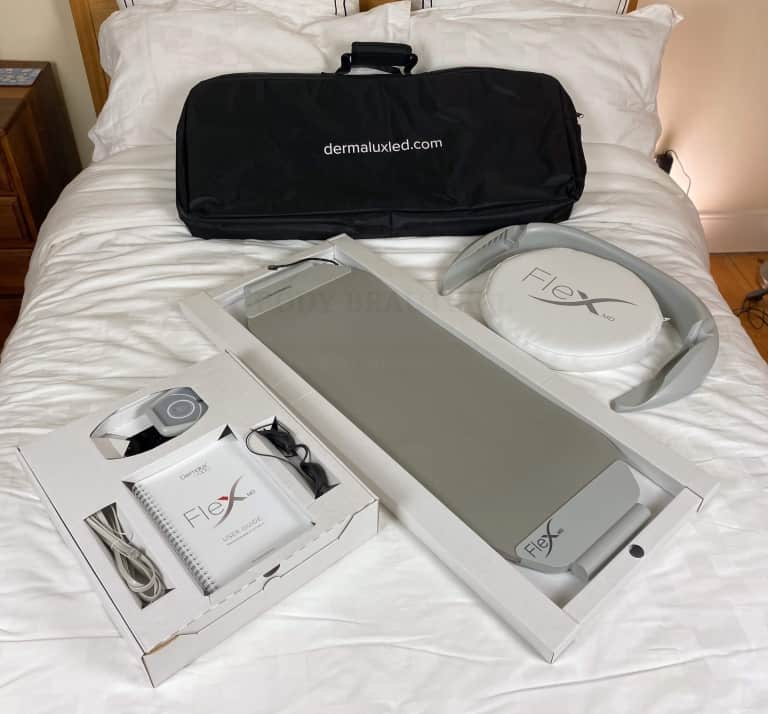
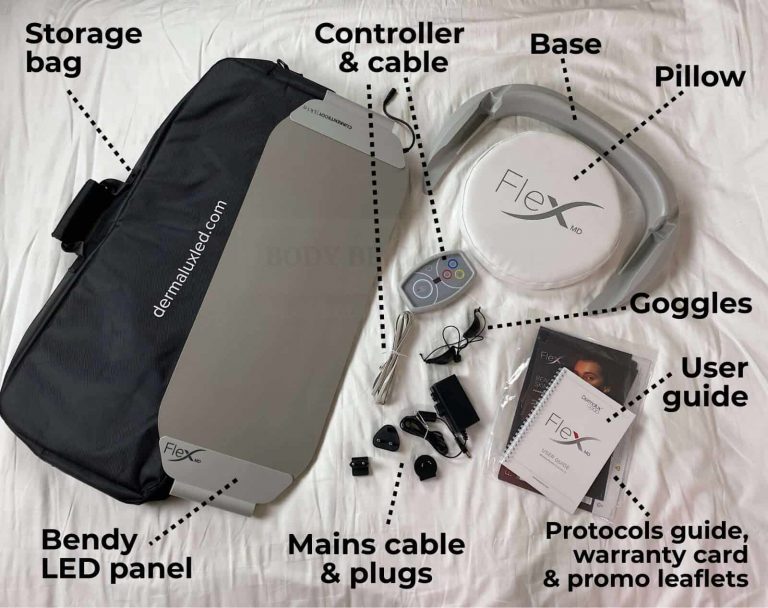
What’s in the box?
- LED array panel
- Storage bag
- C-shape base
- Pillow
- Controller & cable
- Mains cable & plugs
- Goggles
- User guide
- Protocol guide
- Warranty card
- Promo leaflets
All the kit bits fit neat in the large storage bag provided. This keeps everything together and conveniently portable. However, it’s worth hanging onto the Flex MD cardboard box too for extra sturdy storage protection against knocks.
Quality & design
Use the LED panel as a canopy for treating your scalp, face and neck. Alternatively, lay it flat against your skin on your chest, back, tummy and other body areas. The design is functional versus stylish, coloured in a neutral but rather dull grey.
The mains-powered LED panel is 1.5cm thick, and three layers of a body-safe foam-like material that’s sturdy but surprisingly bendy. It’s a robust, durable and flexible construction which should last well with care. Embedded on the underside is the neat network of LED lights paced every 2cm and protected under a wipe-clean transparent cover. There are two rigid plastic runners on each end which slide into the C-shape base.
As you move the panel it makes an odd wobbly, scratchy noise which takes a little getting used to!
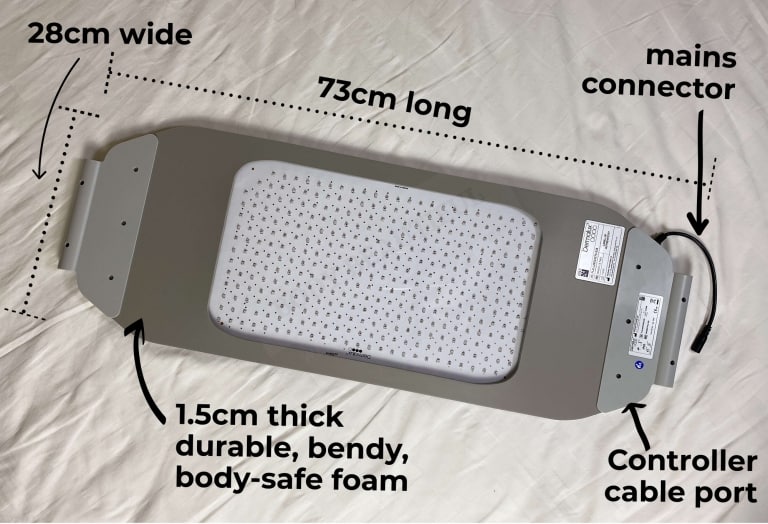
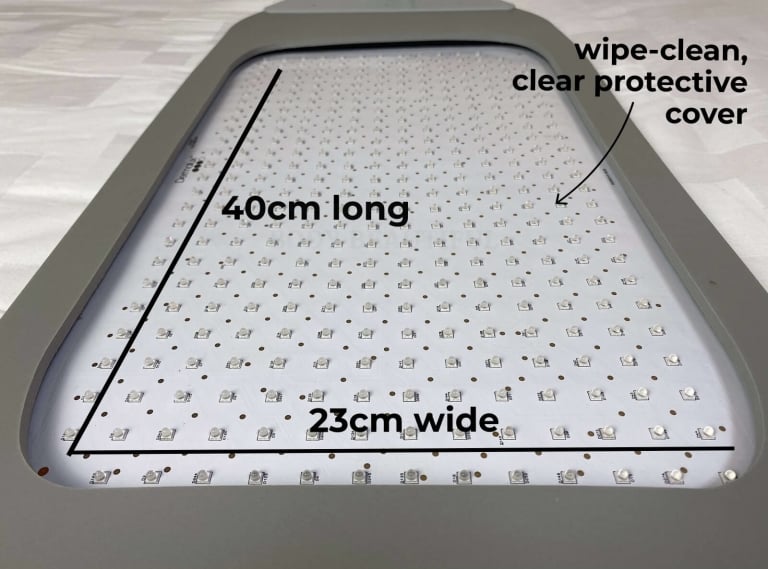
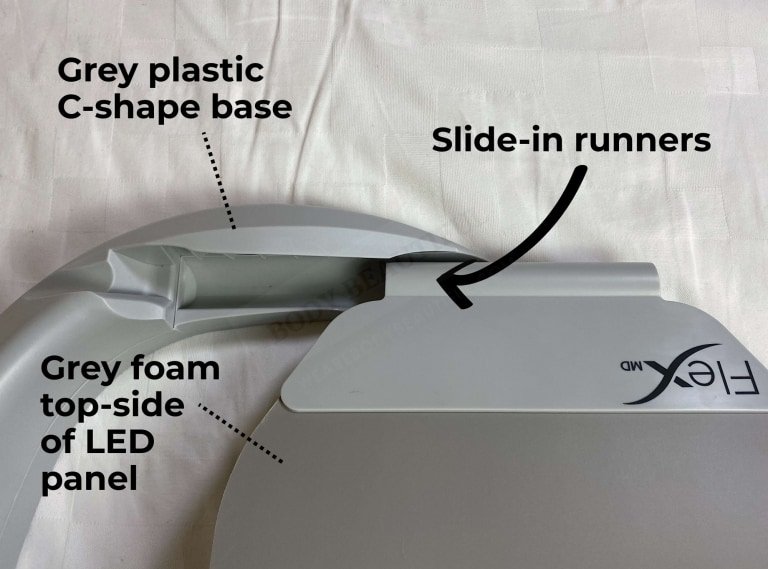
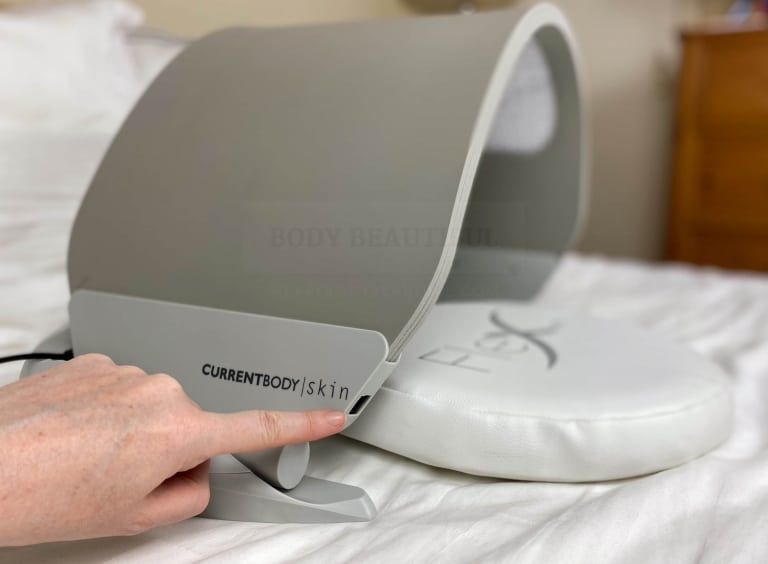
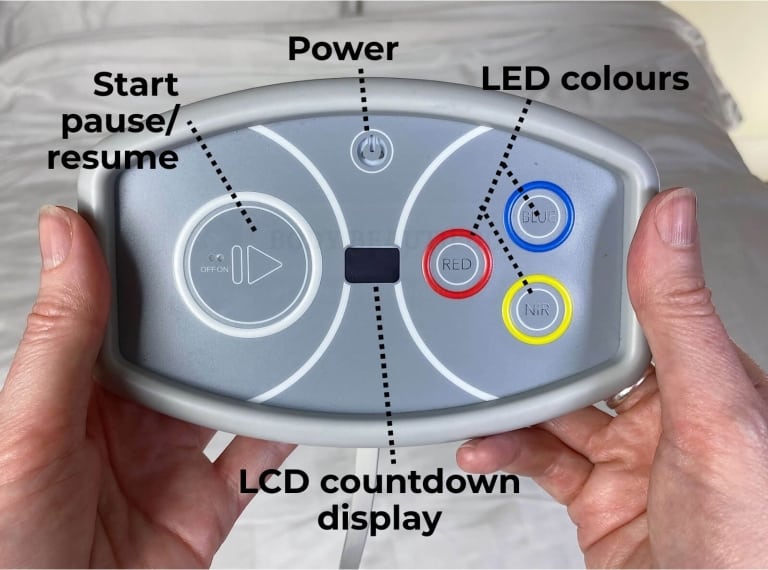
The controller is lightweight and compact. And if I’m being pernickety, it’s also a bit plasticy and bland compared to the more refined styles of other top home use device brands. But it’s a minor point because it does the job well.
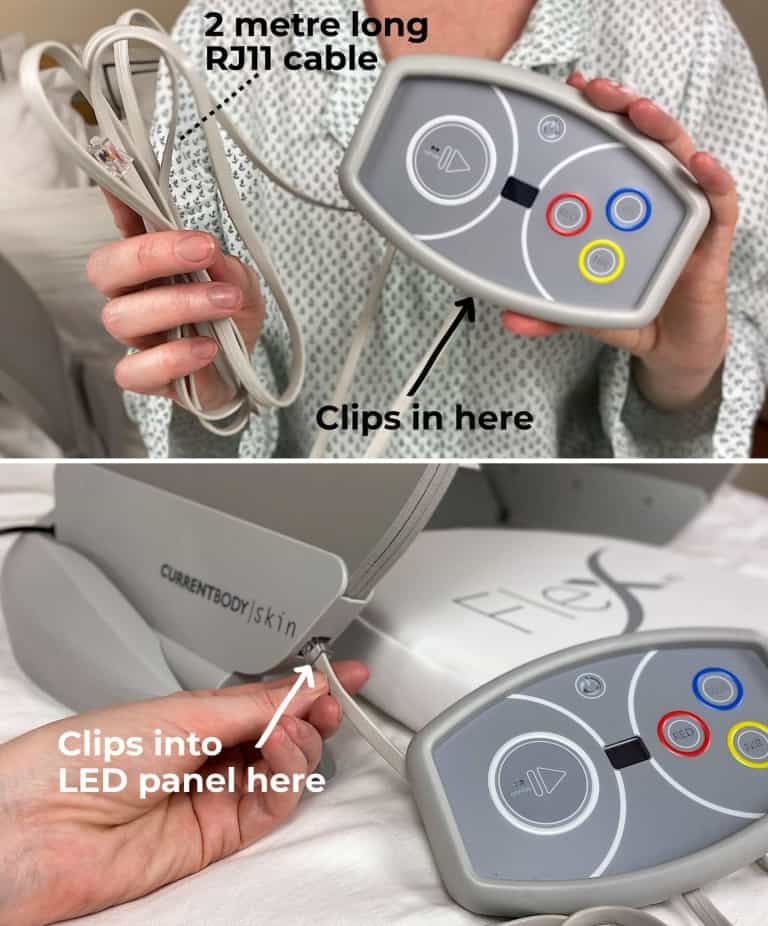
Attach the controller to the LED panel via the two metre RJ11 cable. This has rather old-school clippy-connectors at each end, like those on your landline phone or wireless router. One clips into the corner of the LED panel and the other into the base of the controller.
TIP: The RJ11 cable is a little difficult to disconnect from the controller if you don’t have long nails to release the clip. You can use a pin or simply leave the cable plugged in, which also avoids wear of the plastic clip mechanism.
The mains cable is a good 1.5 metres long and it comes with UK, European and Australia mains plug adaptors. There’s enough cable to plug this in beside my bed, but you may need an extension cable if your socket is further away.
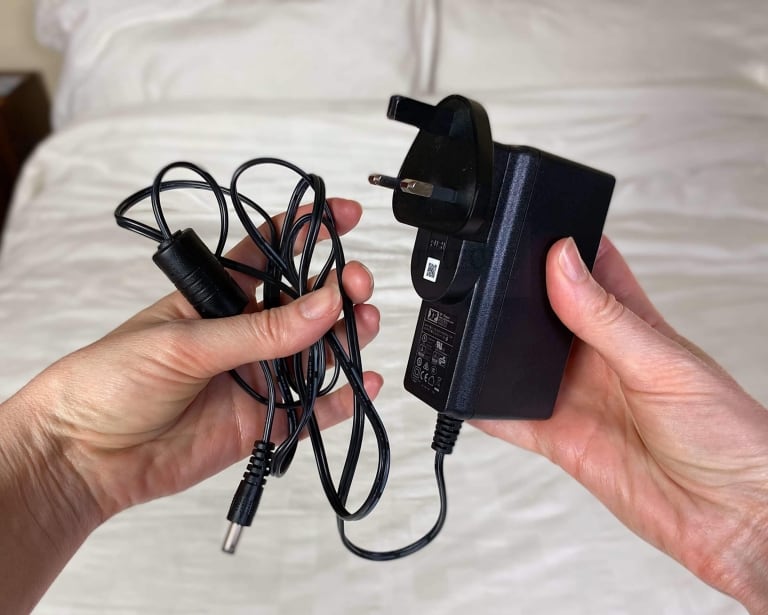
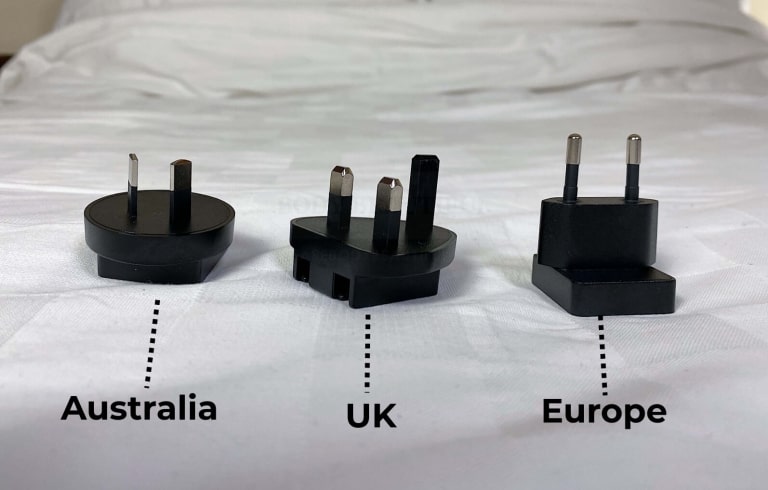
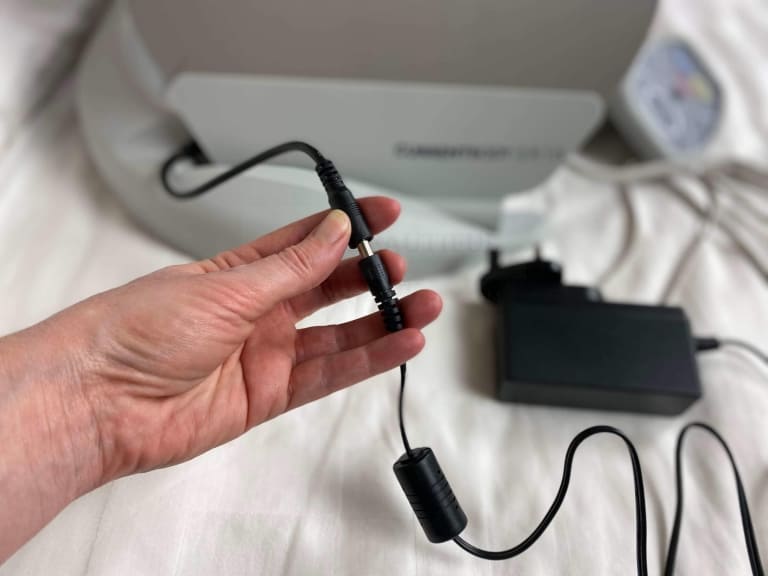
TIP: the mains cable and the controller both connect to the left-hand side of the LED panel, with the mains cable back-left when in the base.
However, the quality of the mains cord is rather disappointing. Other home devices with thicker, more supple cords and more expensive materials not only look and feel better, but are more durable too. It’s not such an issue with the Flex MD because it’s a stationary device. But, for the price of this very expensive kit, I expect more. So, take extra care whilst coiling the cables, and packing and unpacking the kit into the storage bag.
The Flex MD comes with a good 2-year warranty.
Next, let’s look at the impressive claims Dermalux make for the Flex MD.
Are Dermalux claims real?
Dermalux make some bold claims about the Flex MD. They say:
👉 #1 They have unique LED technology (it’s won awards 5 years running, don’t you know). But what exactly is so darned special about it?
👉 #2 It’s the world’s most powerful home LED device, and specifically 3x more powerful than the closest rival.
👉 #3 It gives professional-level results at home, faster and better than the competition.
I’m not one to blindly accept or repeat marketing claims. A healthy dose of scepticism means I can’t help but question the what, how, and why until I really understand something. Therefore, I did some digging into these claims. So…
First, let’s look at the LED technology in the Flex MD and how it compares to rivals.
#1 Unique LED technology?
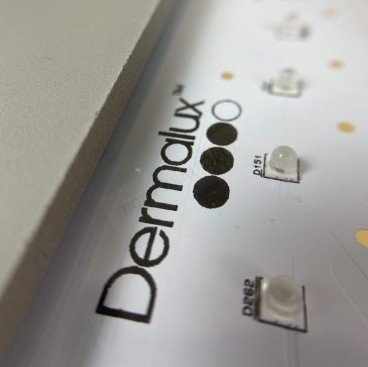
If you’ve done a little interwebs research on home LED devices, you’ll know there are typically three important specifications given by manufacturers.
These are:
- The wavelengths in nanometres (nm)
- The optical output power in milliwatts per centimetre squared (mW/cm2)
- And the dose, or total amount of optical power emitted during a session in Joules per centimetre squared (J/cm2)
Here’s this data for the Flex MD (just in case you’re curious):
| 🔴 Red | 🔵 Blue | 🟡 NIR | |
|---|---|---|---|
| Wavelength: | 633nm | 415nm | 830nm |
| Power: | 11.5 mW/cm2 | 5.52 mW/cm2 | 5.5 mW/cm2 |
| Dose per 30 mins: | 20 J/cm2 | 10 J/cm2 | 10 J/cm2 |
Now, armed with this data, it’s tempting to compare it and chose a device which doses your skin in the most advertised photon ‘juice’. Right?
Wrong. Because the problem is, on paper most devices present almost identical numbers. It’s proper confusing 😕.
So, why is this and how can you tell the best from the rest?
I asked team Dermalux to explain. And I was pleasantly surprised when co-founder Louise, and Managing Director Dale, took time on a Zoom call to patiently delve into key areas of photonics science and the Flex MD design.
Proven therapeutic light
So, it’s no surprise Dermalux adhere to the proven therapeutic science of light therapy. They use only clinically proven wavelengths (415nm, 630nm and 833nm). We know the target areas in our cells readily absorb these. And they use ample optical power to reach these key areas, thus triggering the desired biochemical changes in our skin. With hundreds of LEDs too. But, there’s much more to it than this.
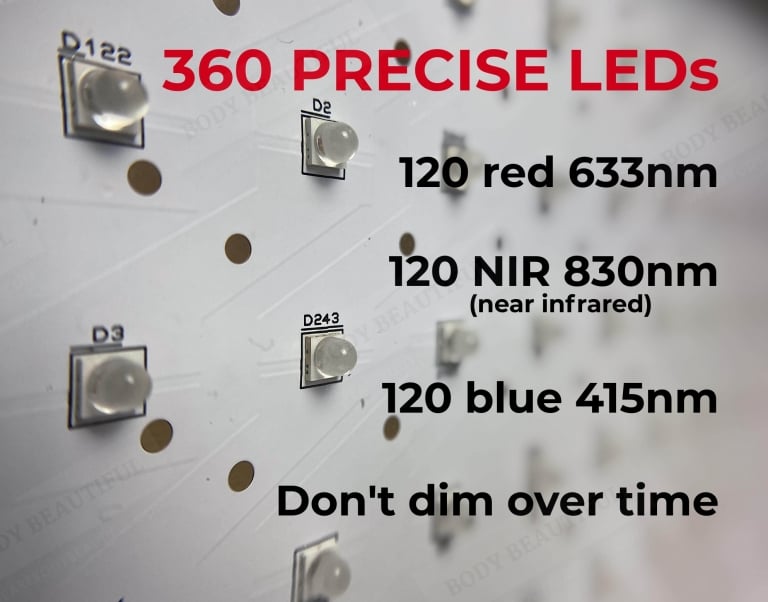
Dale further explained, it’s not only about the optical power, but the precision of this photon energy which directly and markedly affects results. And this precision is determined by the quality and stability of the LEDs.
And Dermalux LEDs are unique because they don’t use standard cosmetic LEDs. They start with the best of these, and then refine them. Again, and again. They end-up with top-quality ultra-precise light energy. This means the target organelles of our cells absorb virtually all the delivered photon energy. It’s so advanced, precise, and secret-squirrel that Dermalux designed their own scale to measure and manufacture their LEDs. No-one else has them. So yup, their LED technology is unique.
OK, but… how are their LEDs better?
Photonics stuff
Dale explained he precisely shapes the light energy to be much more efficient and effective on our cells.
Here’s an illustrative diagram of a standard LED waveform.
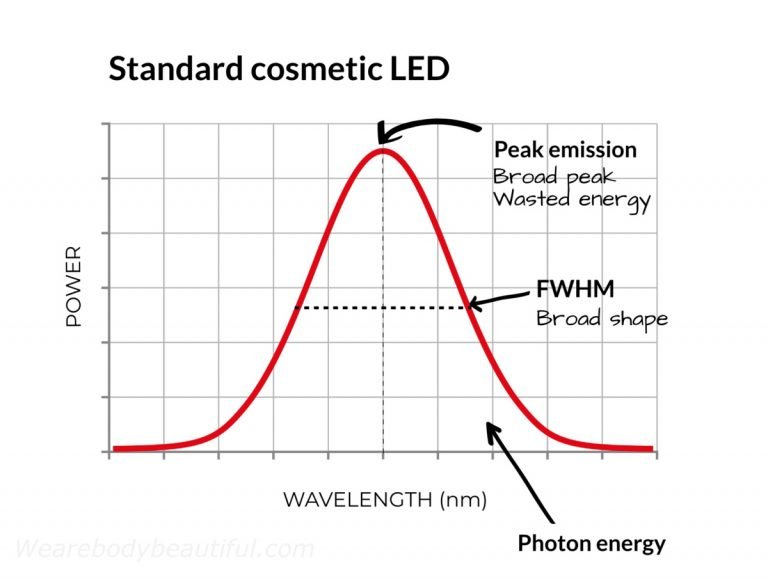
In comparison, Dermalux LEDs are further refined. They have a waveform with a narrow ‘Full width half max’ (FWHM) and a high peak emission. This ‘pointy’ shape is best because it’s high energy and narrow, so more of the photon energy focuses precisely on the therapeutic wavelength ‘peak’.
Rival devices, with standard and less precise LEDs, comparatively deliver some photon power at the desired wavelengths. But the overall shape is much less efficient and effective.
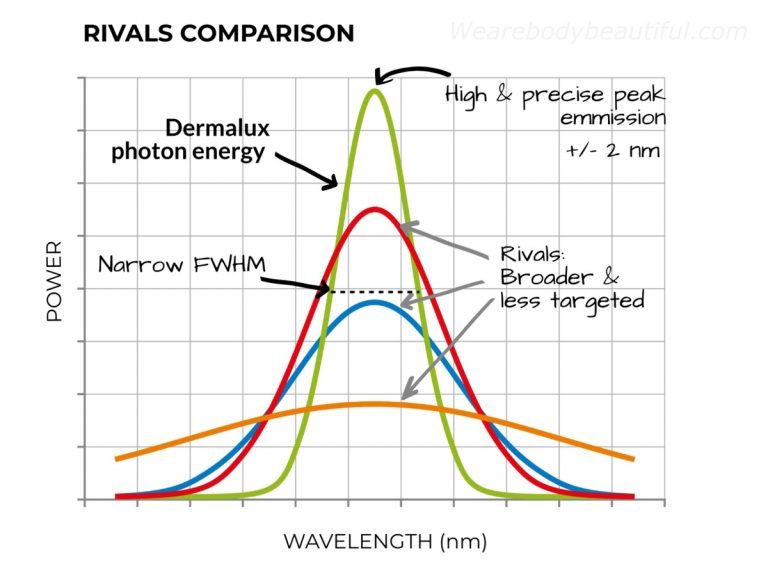
In less refined LEDs, the lower broad peak and broader FWHM means much of the energy misses the target absorption point in our cells. Therefore, most of it is wasted.
With a Dermalux LED, the FWHM is +/- 12 to 15 nm, and the peak emission is ultra-precise at +/- 2 nm. That’s versus +/- 5 to 10 nm peak emission typically in other devices. It may not sound much, but in photonics, it’s HUGE.
So, that’s the difference between standard and Dermalux quality LEDs. But equally important is keeping the LEDs cool and stable…
Cool LEDs are stable
LEDs generate heat, and heat reduces their overall optical efficiency. So, it’s vital to keep the LEDs cool. Cool LEDs mean precise and powerful energy, consistent from session start to finish 😎.
To do this, the Flex MD borrows cooling technology from Dermalux largest machine, the Triwave MD. Multi-layers of copper conduct and draw heat away from the LEDs. This also keeps the Flex MD LED panel light-weight and flexible.
Cheaper rival devices don’t have this cooling capability. So, they also don’t output stable, consistently powerful light energy.
Alrighty. Now onto power…
#2 The World’s most powerful home LED device?
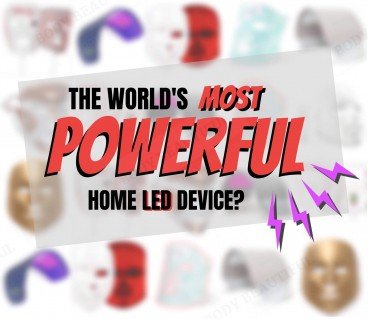
Now, I’ll be honest. The first time I heard this claim it made me feel all itchy. That’s because:
a) it sounds like the myriad other overzealous and unsubstantiated claims designed to ‘wow’ us, and
b) on paper, the power output from the Flex MD is super-similar to cheaper home devices.
However, we’ve just now learned how Dermalux powerful, precise, and stable LED tech delivers more targeted energy, right where our cells need it. So, this explains how devices with apparently the same wavelengths and power output can give vastly different results.
But… we’re still just taking Dermalux’s word for it, right?
Well, here, we don’t need to.
Dermalux too were curious to see how they stacked up against the competition. So, they got an independent accredited test lab to accurately measure the optical power delivered by the Flex MD, and that of the other leading home LED devices.
The tests measured the optical power and wavelength precision of each device resulting in the optical power output (J/cm2) during a session.
And, you guessed it… the Flex MD came out on top! 🥳🎉👯♂️
The results confirm the
✔ accuracy and
✔stability of the Flex MD, and that
✔ the advertised power and dose is spot on.
That’s compared to the rival home devices where the power fluctuates during a session. This reveals their advertised power output (typically based on manufacturer LED standards) to be much lower in real-life tests.
Unfortunately for us, this juicy report is not publicly available. That’s to avoid an inevitable global home-beauty photonic tech war from erupting. It’s safer this way. However, Louise did share data from the resulting report comparing the Flex MD to its closest at-home competitor. I saw it with my own eyes, and I can confirm this data shows the Flex MD does indeed deliver 3x more optical energy💪.
So, I’m convinced the Flex MD is the most powerful home LED device. But does this mean it gives professional-level results?
#3 Professional-level results?
This is such an over-used and misleading claim made by home beauty tech brands 🙄 (IMHO).
“Professional-level results” implies results from home devices are every bit as good as those from their in-clinic technology counterparts. And whilst these scaled-down, less powerful home versions can improve your skin, results typically are slower and much less significant.
So, I thought this was more of the same predictable over-hype. That’s because the Flex MD is also a scaled-down, less powerful version of Dermalux’s flagship in-clinic (and bad-ass) Triwave MD LED system.
But wait 🙋♀️.
The portable Flex MD may be less powerful and therefore smaller and light-weight, but it has the exact same LEDs inside. Therefore, this home-version Flex MD is still considerably bad-ass.
But you don’t need to take my word for it this time.
That’s because, just like the TriWave MD, it’s a CE certified medical device.
So, why’s this a big deal?
CE medically certified
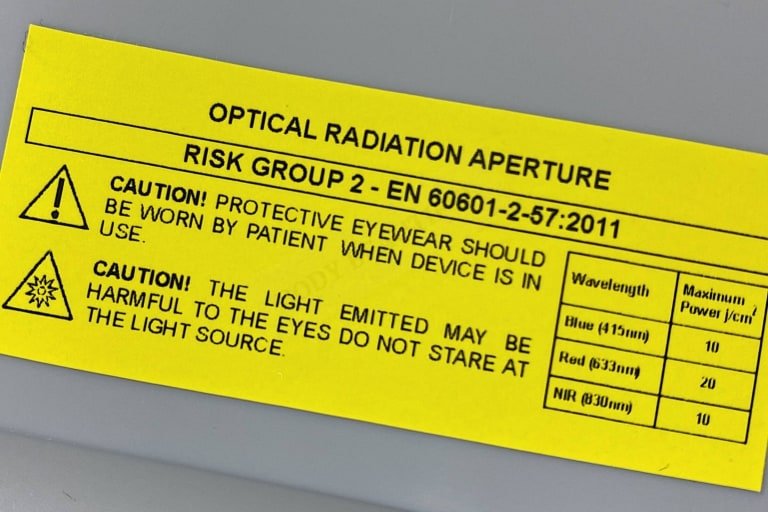
GOOD TO KNOW:
The Flex MD is CE medically certified under directive EN 60601-2-57:2011 to treat:
✔ acne, ✔ psoriasis, ✔ healing ✔ & pain
European medical certification is hard to get. It means an independent party – called a Notified Body – has continuously reviewed your device against super-comprehensive and strict directives. These are much tougher than self-assessed, non-medical CE directives (focused primarily on health and safety), which purely cosmetic LED devices require. It’s also tougher than the United States FDA medical clearance process. This is why:
First, the manufacturer must gather extensive clinical evidence supporting the science and technology. They must also design, document, and build the device to meet the applicable set of directives. This then ensures it’s safe to clinically test.
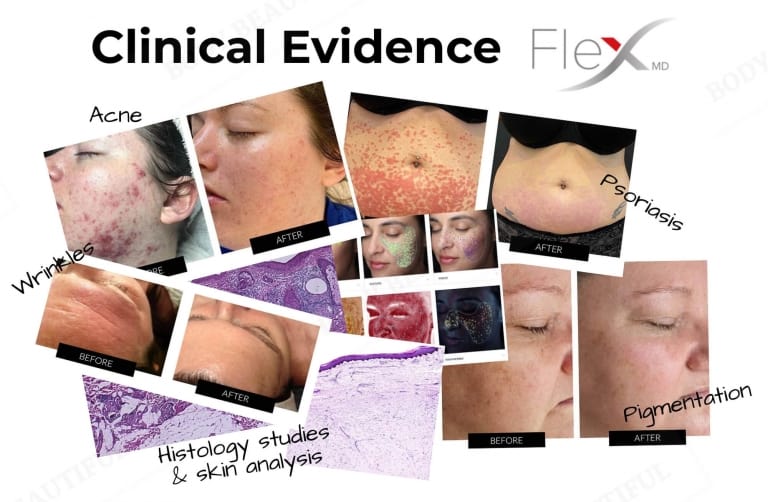
And, because we demand effective medical devices, there’s a much keener focus on detailed clinical evidence, such as skin analysis and histology studies. It’s assessed and approved by a team of qualified clinicians. Finally, once manufacturing meets consistent standards, the Notified Body certifies it as a medical device for sale in the EEA. And it’s a globally recognised medical certification.
Phew.
👉 This means its therapeutic light starts significant biochemical changes in our skin and tissues resulting in healing, regeneration and relieving pain. The Flex MD is not ‘professional-level’ or ‘medical-grade’.
It’s simply a professional medical device you can use at home.
IMPORTANT: Don’t be fooled by rival home devices who say they use “medical-grade” LED technology. This sounds reassuring – and that’s the aim – but it’s simply not the same.
👉 Treating real medical conditions requires much higher quality and power light energy which is much harder to deliver. Therefore, it’s not found in cheaper, purely cosmetic home devices.
Ok. Still here? Jolly good. Let’s run through what this baby is like to use!
Before you start
Before you start, read the user manual. It’s a quick and easy read with some helpful diagrams. It explains how to set it up, how to use it, cleaning instructions and maintenance.
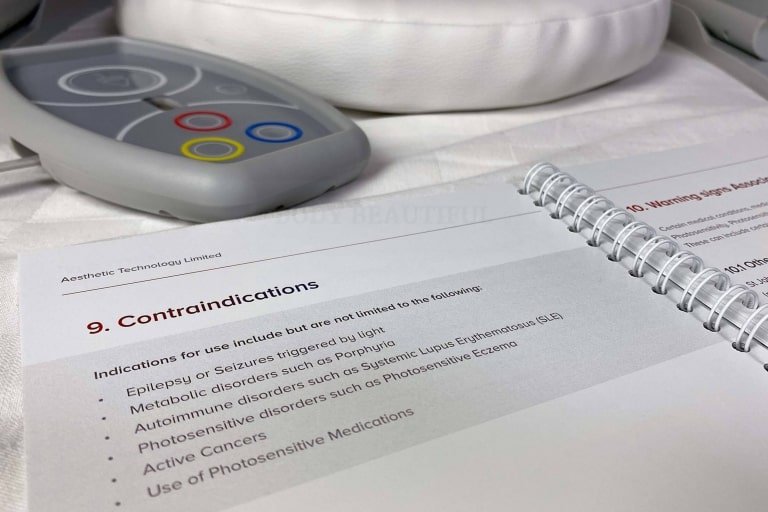
Pay close attention to the warnings, risks, and contraindications. Common reasons you can’t use the Flex MD are light sensitivity, metabolic disorders such as Porphyria, epilepsy or seizures triggered by light, photosensitive disorders such as photosensitive Eczema, active cancers, autoimmune disorders such as Systemic Lupus Erythematosus, and use of photosensitive medications and substances. You can learn more here, and be sure to check the full list in the user manual.
You’ll know already if you have one of these conditions. And because LED light therapy is so well tolerated by everyone else, there’s no need for s kin sensitivity test before your first session!
IMPORTANT: Although not explicitly contraindicated by Dermalux, the LED panel is not tested for safety if you’re pregnant 🤰, so the risks (if any) are unknown.
👉 AND, be extra careful if you have eye disease and conditions including Glaucoma, Cataracts, recent laser eye surgery or light induced migraines and ALWAYS wear the goggles provided 🕶
Next, let’s look at how you use it…
How to use the LED kit
Find a comfy spot and get yourself set up. I choose my bed in the privacy of my bedroom. You can do it any time of the day, but I prefer a relaxing evening wind-down routine.
Set-up the canopy in the c-shape base for your face. Or leave it flat for body areas. Attach the controller to the LED panel. Then, connect the mains cable, plug into and then switch on the mains. Have the goggles handy too.
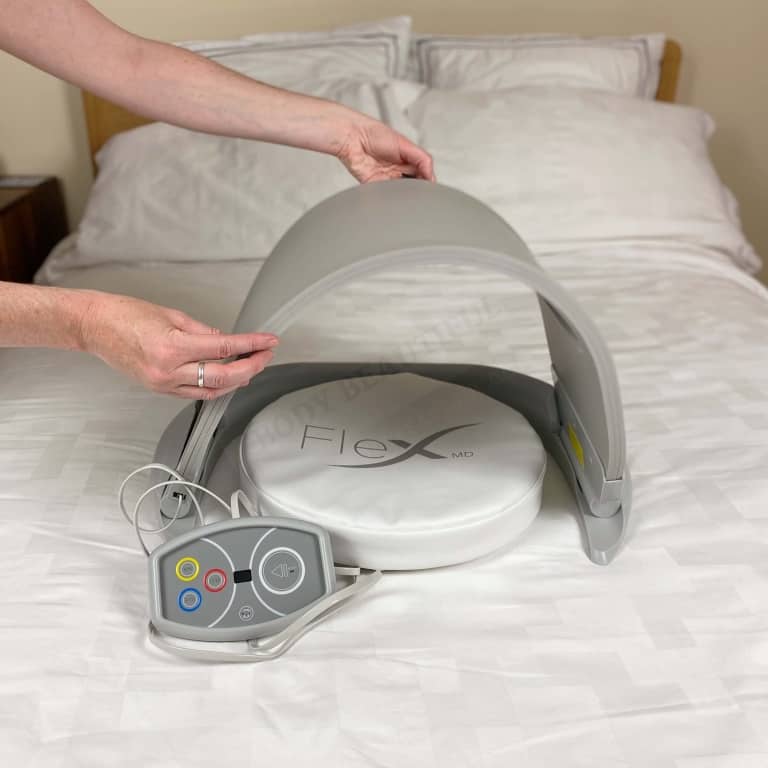
To start your session, gently tap the power button so it lights up green. Then, gently tap each of the LED colours you want to use in your treatment. The buttons illuminate once selected.
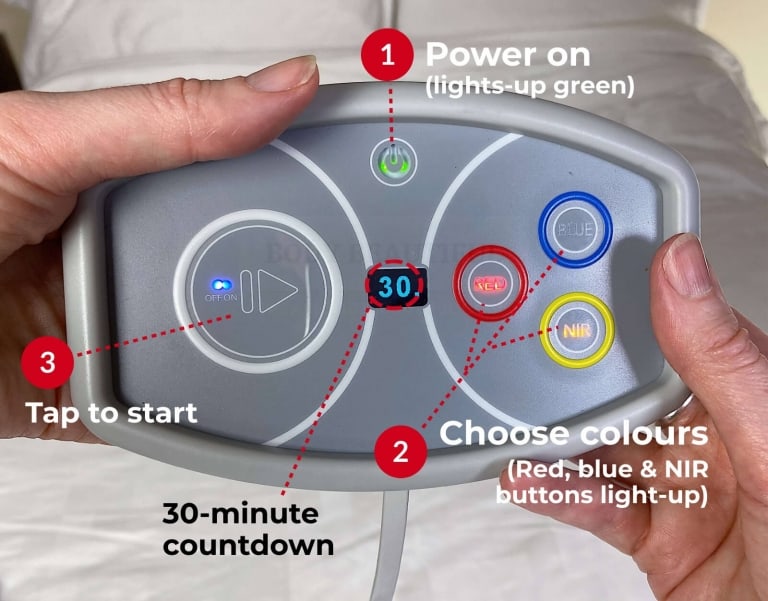
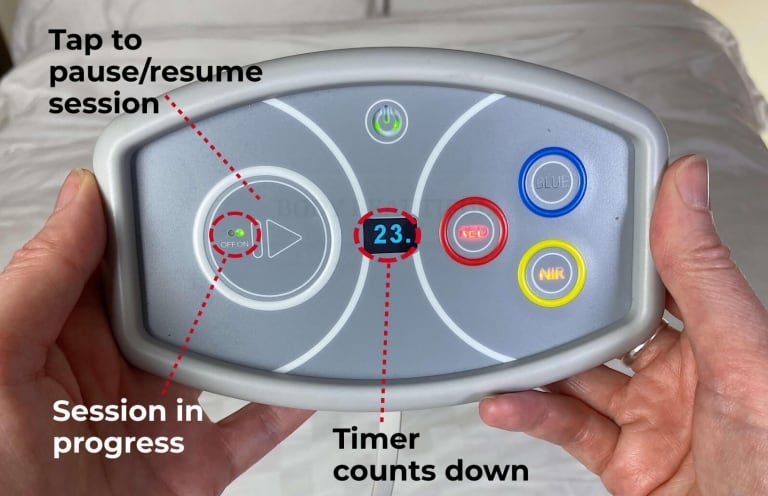
Each facial session under the canopy takes 30 minutes. So, simply lay back and relax until the device auto shuts off once the 30 minutes is up. I either take 30 in a silent meditative rest 💤, listen to the radio, music, or a podcast.
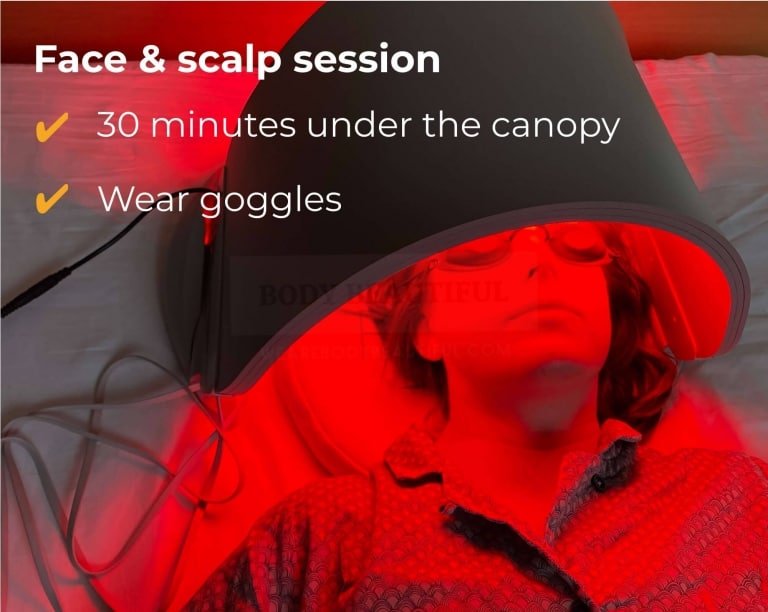
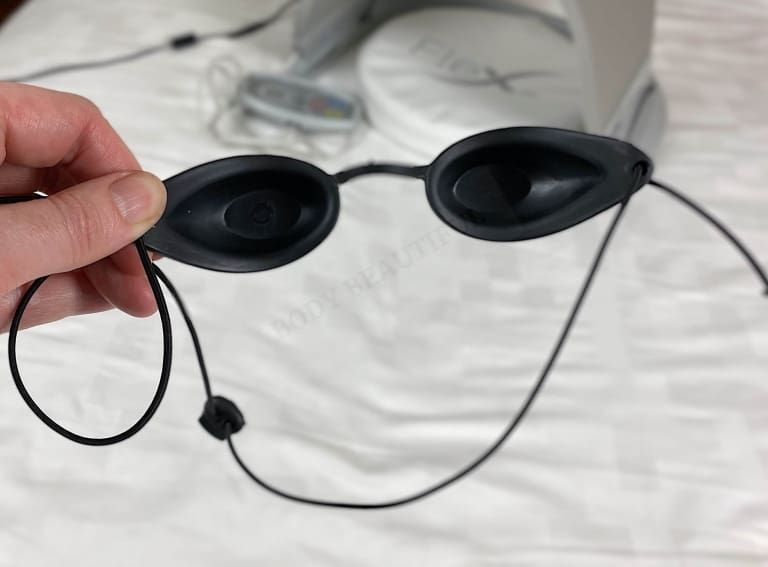
TIP: Once you’re under the canopy, simply lay the goggles over your eyes rather than tightening them around your head
Reduce the session time to 20-minutes for body areas where you lay the LED panel across your skin. You need less time because it’s so much closer to your skin. There’s no 20-minute option on the timer. So, you must stop it manually once the 20 minutes are up. Simply set an alarm on your phone, or set a timer with your friendly virtual home assistant.
I focus on my décolletage/chest, but also tummy, knees, and legs if I have time. I simply remove my clothing and lay the LED panel across my body, or long-ways down the front of my shins. The LED panel is 40cm wide which covers the width of my body comfortably. I watch TV and treat as many areas as I can during an episode or two.
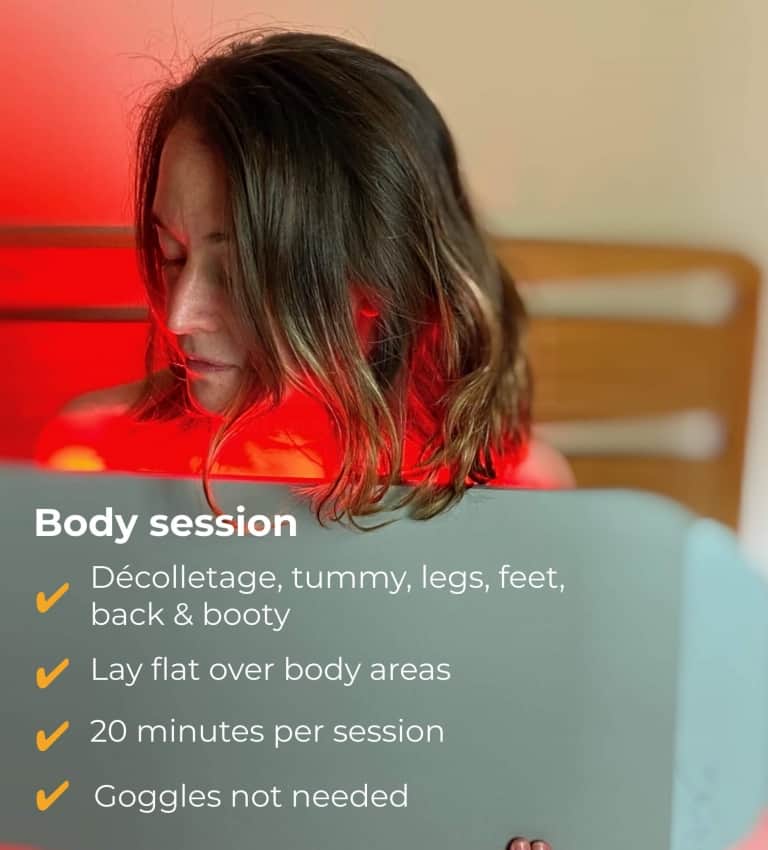
Once you’re done, power off the controller. Dismantle the kit and store it safely in the storage bag away from direct heat or sunlight. Or, if you have the space leave it all assembled on a bed, but turn it off / unplug it at the mains.
The LED routines
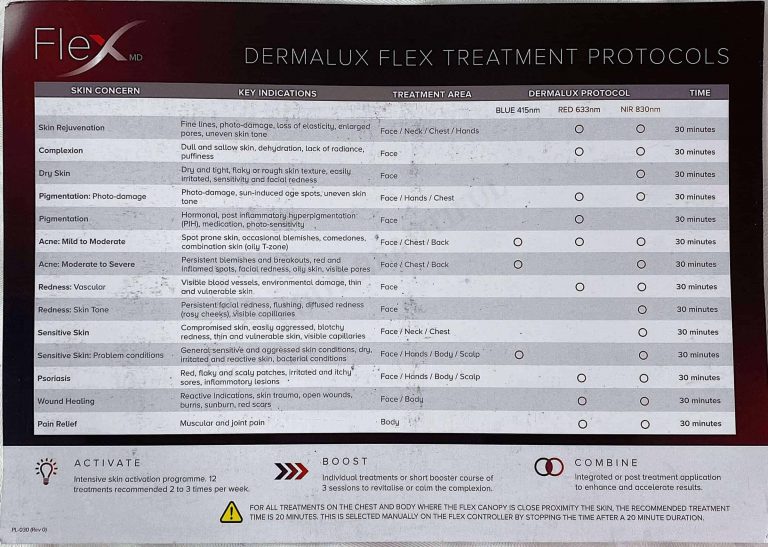
You get a handy treatment protocols reference guide to match your skin goals to the correct combination of lights and face or body areas. Most protocols combine both red and NIR light to treat a variety of skin concerns on your face, scalp, neck, chest, hands, and body. Blue light is always combined with NIR, or both red and NIR lights for best results.
MORE THAN ONE SKIN CONCERN?
If you have more than one concern (which are separate on the protocol sheet or in the lists below), select ALL the wavelengths that apply, in one session.
For example, if you want to treat both acne and anti-aging at the same time, choose blue, NIR and red combo. Also, if you suffer from facial redness, using NIR along with red helps both the redness and overall anti-aging concerns.
Here are the wavelengths/colours to use for various skin concerns and conditions:
🔴🟡
Red & NIR combo
Face, neck, chest & hands
Skin concerns
➕ Fine lines & wrinkles
➕ Loss of elasticity
➕ Dehydration
➕ Large pores
➕ Dull, uneven tone
➕ Sun-damaged skin
Results: Rejuvenates & perfects
✔ Brightens & hydrates
✔ Firms, tones & depuffs
✔ Smooths bumps & wrinkles
✔ Clarifies redness
✔️ Refines pores
✔ Fades fine lines , spider veins, dark spots & scars
Skin injury
➕ Sunburn
➕ Open wounds
➕ Red scars
➕ Thin and vulnerable skin
➕ Psoriasis
➕ Muscular or joint pain
Results: Heals & relieves
✔ Thicker & stronger skin
✔ Wounds & burns
✔ Softens & fade red scars
✔ Relieves & heals dry, itchy, scaly patches, sores & lesions
✔ Soothes muscle & joint pain
🔵🔴🟡
Blue, red & NIR combo
Face, neck, chest, body, hands
Mild to moderate acne
➕ Spots
➕ Blemishes
➕ Oily skin
➕ Breakouts
Results: calms, soothes, heals, clears
✔ Kills acne causing bacteria
✔ Regulates sebum/oily T-zone
✔ Controls & heals blemishes, spots & comedones
🔵🟡
Blue & NIR combo
Face, hands, body, scalp
Moderate to severe acne
➕ Persistent blemishes
➕ Breakouts
➕ Red & inflamed spots
➕ Facial redness
➕ Visible pores
Results: calms, soothes, heals, clears
✔ Kills acne causing bacteria
✔ Regulates sebum/oily T-zone
✔ Calms & heals red & inflammed skin
✔ Heals & controls breakouts
Sensitive skin conditions
➕ Dry & irritated skin
➕ Bacterial skin conditions
➕ Reactive skin conditions e.g.
➕ Rosacea
➕ Eczema
➕ Dermatitis
Results: Calms, heals, protects
✔ Calms bacterial & reactive conditions
✔ Soothes & repairs dry, irritated patches
✔ Keeps skin strong, hydrated & healthy
✔ Prevents bacterial infections (after dermarolling etc)
🟡 NIR (Near Infrared)
N.B. You can’t see NIR light!
Face, neck & body
Skin conditions
➕ Dry, tight, flaky skin
➕ Rough skin
➕ Redness e.g. diffused redness
➕ Visible capillaries
➕ Compromised, thin & vulnerable skin
Results: repairs & protects
✔ Repairs & smooths skin barrier
✔ Calms redness
✔ Heals, hydrates & thickens delicate skin
🔴 Red
Face
Hyperpigmentation & dark spots caused by:
➕ Medicines
➕ Hormones
➕ Post inflammatory hyperpigmentation (PIH)
Results: repairs
✔ Fades hyperpigmentation
✔ Evens skin tone
What does it feel like?
First, I like that there are no gels to use as with other home devices. Apply your serums and moisturisers after your LED session so nothing in your skin obstructs or diffuses the LED.
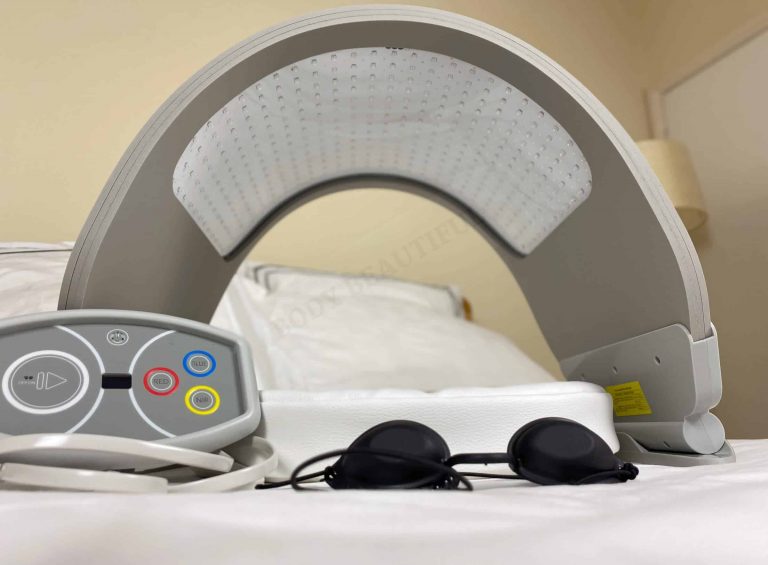
It’s a little awkward to get under the canopy – I slide in whilst tilting the base and canopy backwards, then position it around my head. I like to get comfy under the canopy, close my eyes and start the lights, and then place goggles over my eyes. Or you can start the lights and then shimmy under the canopy if you prefer.
And the lights are super bright, so wear the goggles provided. They’re totally opaque so are excellent at shielding your eyes. You don’t need to tighten the strap around your head. Simply lay the goggles comfortably over your eyes – it does the job and ensures nothing digs in. Wearing them, you can see the colour of the lights but it’s not overly bright.
The wipe-clean low pillow gives good support and keeps your head at the ideal distance from the canopy. Make sure the canopy is right above your face so the light reaches your neck too. If it’s too far back, you can slide it forward slightly on the runners.
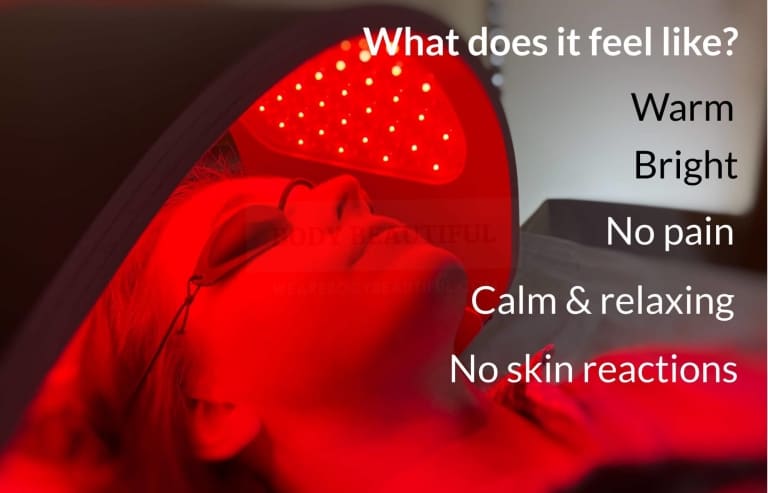
It feels pleasantly warm under the canopy and never gets too hot. It feels safe and calming, and I find it a very relaxing way to spend 30 minutes. I like to listen to a podcast or music. Afterwards, my skin is sometimes pink due to increased blood flow, but there’s no stinging or other sensation. However, I do find everything has a slight bluey-green hue afterwards and it takes a few minutes for my eyes to readjust.
TIP: headaches are rare but possible after your session. Stay hydrated before and after, and take pain killers if needed.
It’s a bit trickier for body areas, but easy once you know how. Lay the LED panel flat over your chest, tummy back and other body areas. The LED array is wide enough to cover the width of my body. It’s not too heavy, but the edges can dig in a little depending on your body angle. Try positioning a couple of pillows down your sides to make it comfier. I pile up a few pillows, test the angle, whip off my top then position the panel. I keep my arms under the panel with the controller on my right-hand side. There’s no need to wear the goggles so you can watch TV or read during the 20-minute session.
IMPORTANT: Don’t lie on or put weight on the LED panel, or bend it beyond the shape of the canopy! You’ll break it!
There’s no 20-minute countdown option, so I set a timer with my Google home assistant. Sometimes, she gets it right.
Schedule, effort & results
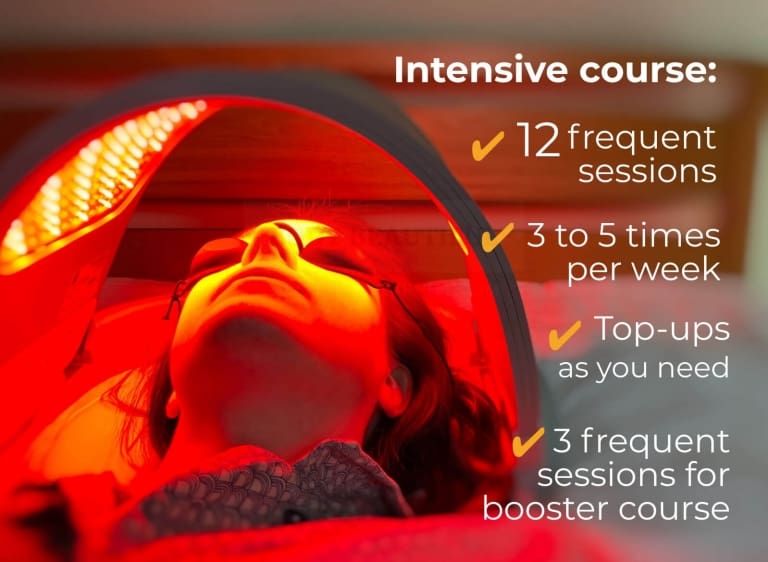
Do twelve frequent sessions per area, 3 to 5 times per week. Continue if you like or reduce them as you see fit. Two or so sessions per week keeps my skin in tip-top condition.
You can also do a short course of three frequent sessions to give your skin a rejuvenating or calming boost. This is handy before a big event, as a pick-me-up, and even during the darker winter months when everything just feels a bit ‘ugh’.
For your face, you must commit at least 30 minutes almost daily to start. Add an additional 20 minutes per body area too. Therefore, it’s time intensive, especially if you treat multiple areas. But it’s very little effort.
I watch TV or read for 20 minutes with red and NIR on my neck and chest, then relax for another 30 minutes under the canopy for my face. So, I’m done in 50 minutes. I set aside a quiet hour, usually just before bed. I look forward to this relaxing, centring, wind-down time.
And the Flex MD is easy to stick with during the intensive course, because results appear fast.
Some feel the difference with calmed or invigorated skin after just one session. Others see soothed, brighter, hydrated, and healthier skin after just two or three sessions. And the results keep getting better from there.
Skin gradually smooths, firms, and rehydrates, pores shrink, scars, fine lines, pigmentation, spider veins and redness fade, so you’ve a healthy radiant glow instead. Breakouts, dryness, inflammation, and psoriasis calm and heal, and thin, delicate, and vulnerable skin rebuilds and strengthens.
Consistent use gives best results, so complete all twelve sessions quickly to see your best results. Two or three maintenance sessions per week is usual to maintain your new heathy skin.
A note About results…
As with all home beauty tech, results vary by individual. Your lifestyle, overall skin health and skin condition severity determine the breadth and depth of results. And how frequently you need maintenance sessions too.
❤ That said, this sophisticated LED kit is capable of some serious skin lovin’ which other devices simply can’t match ❤.
Learn about my results next…
My Flex MD before & after photos
I’ve tried at-home red light therapy before and I love the ease, simplicity, and my fresh skin results. So, I’m beyond keen to try the Flex MD and see how a medically cleared device compares.
I use the Flex MD with red and NIR for general antiaging on my chest and 43-year-old face. And sometimes I add in blue if I feel a few pesky spots emerging. I do four or five sessions per week for three weeks, then drop to two or three per week. I also use a gentle natural and organic facial exfoliator every few days.
And I can feel the change after my very first session. The next day my face is silky-smooth and clear, like on a good skin day. Then, after three sessions it’s bright and dewy too. And it just keeps getting better.
Gradually, my chest, forehead and cheeks feel firmer and meatier, with more bounce to the touch. And a few sessions combined with blue light lifts several under skin bumps on my chin to the surface so they easily exfoliate away. My under-eyes are brighter and fuller, and old red blemish marks start to fade. My chest is smooth, better hydrated and the red-bib effect is slowly fading too.
I see and feel a significant difference after 8 sessions, taking just 2 weeks. My skin is considerably plumper, firm and supple, smooth, tight and bright. My pores are still teeny too. During the first three weeks, a few more spots work themselves out, but quickly heal and fade. Overall, my skin is significantly more healthy, fresh and revitalized and I think looks several years younger 🥳.
It takes me three weeks to do all twelve start-up sessions. Then I drop to two, sometimes three, sessions per week. I took comparison photos after five weeks.
Note: The ‘Before’ photos are after finishing my Foreo UFO 2 trial, and dropping my Tripollar RF sessions to one every two weeks (to maintain skin tightening under my chin).
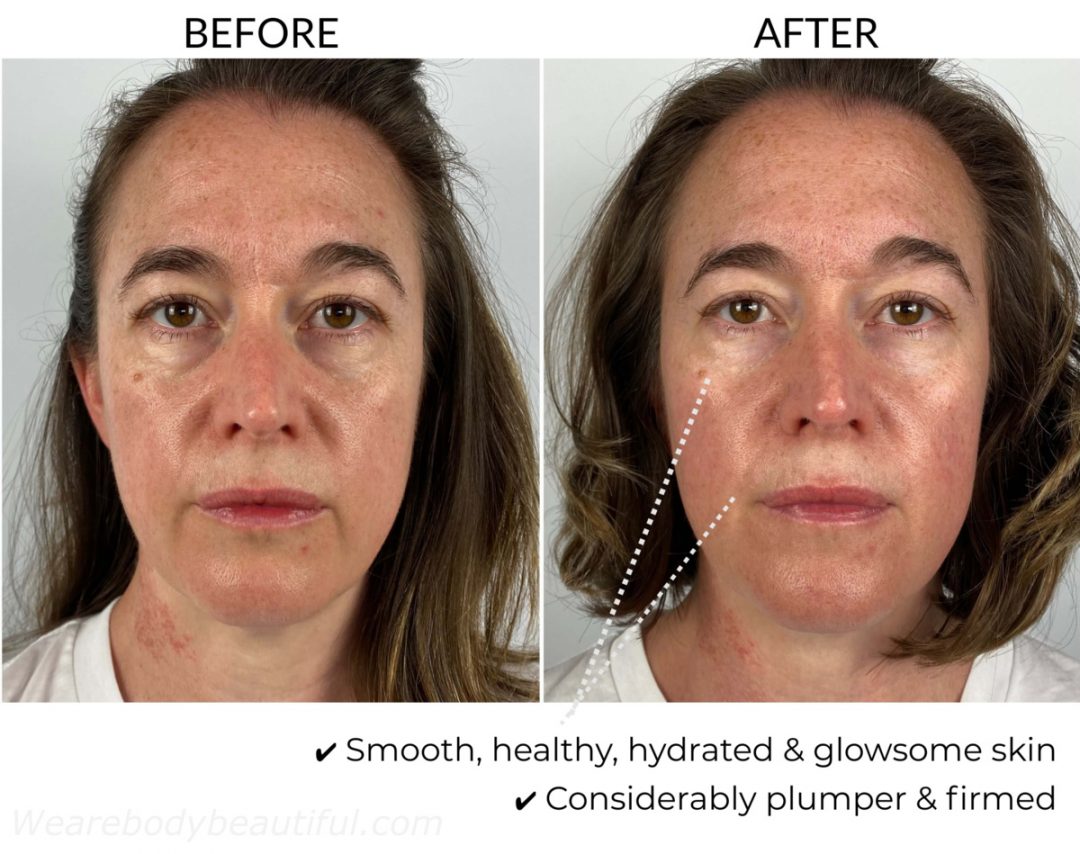
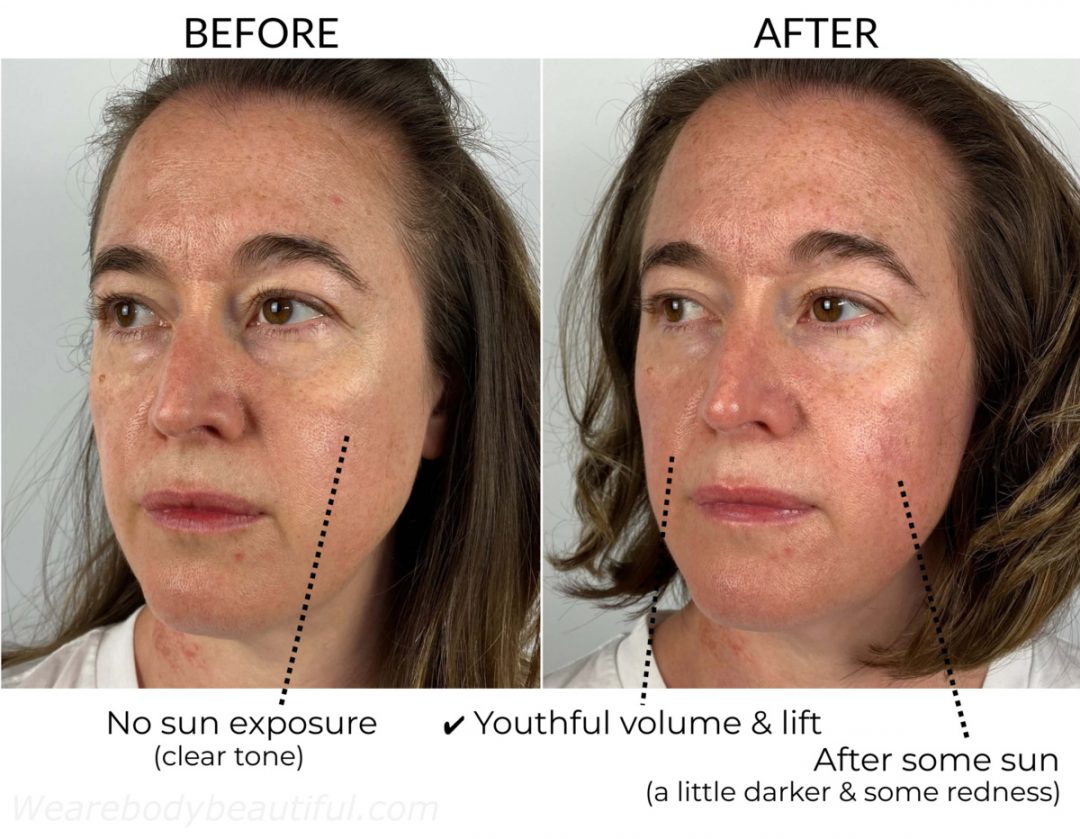
Although my skin is bright, I see small patches of diffuse redness in my after photos. But I think this is because I’ve enjoyed recent sunny weather, which my ‘before’ skin hadn’t seen for several months. However, I still have a few my red spider veins on my cheeks, so unfortunately the flex MD hasn’t faded these at all.
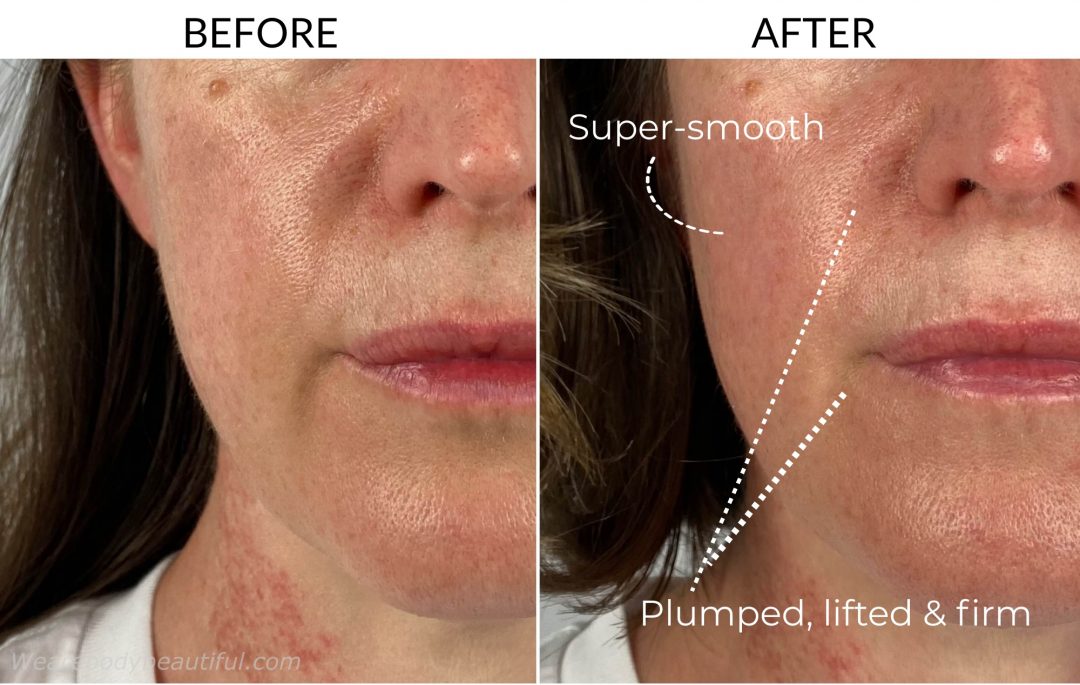
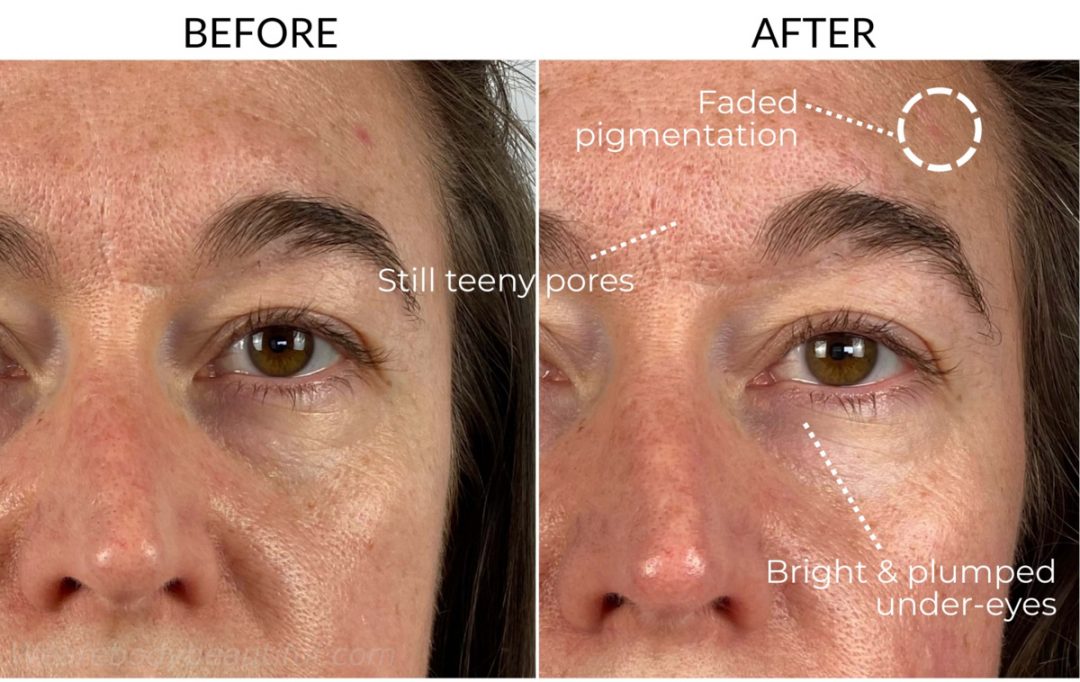
I also use the Flex MD on the several bruises and owies I collect on my shins. It stops the bruises in their tracks, and helps strengthen the very thin skin I have in this area.
My results with the Flex MD came much quicker than with the flexible red light face mask I used previously. I loved my results from that, but they’re much more pronounced with the Flex MD. I see and feel the difference most with the delicious youthful, plump volume and hydration. And the blemish busting power of the blue light.
The negatives
There are a few negatives to consider with the Flex MD. I’ll get to the hefty price tag after a few minor points…
First, it’s rather a large piece of kit. This means you need a safe space or ideally a spare bed to leave it assembled when not in use. If you don’t have this, you must pack it into and out of the storage bag (or box if you keep it) for each session. This is a bit of a faff but is super important to protect this very expensive investment!
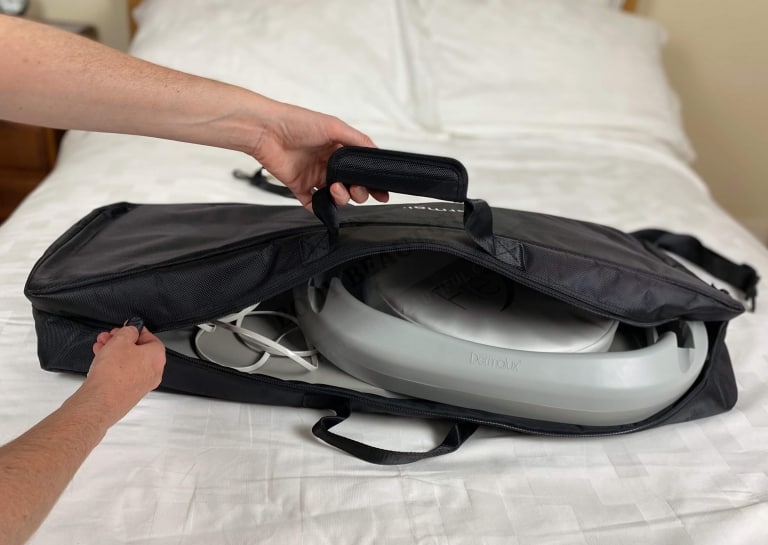
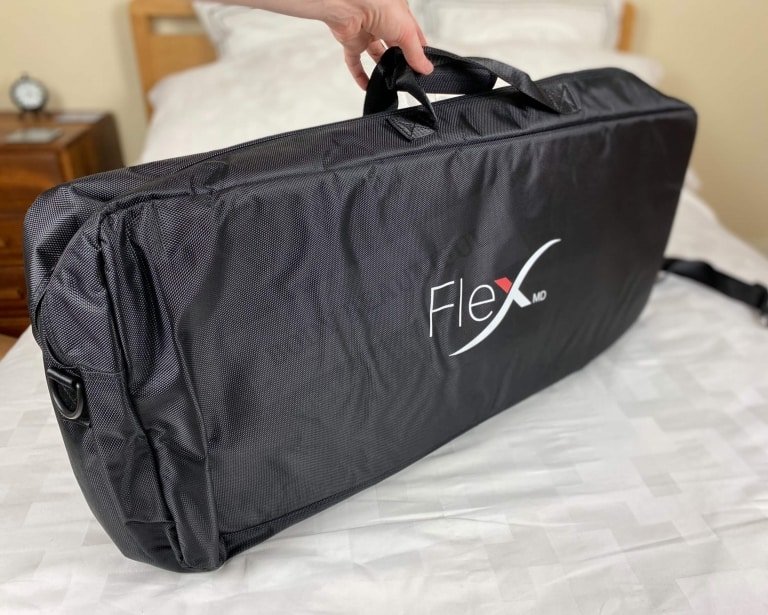
Second, as mentioned earlier, although it’s easy, it is time intensive. A facial session demands 30 minutes out of your day. This is a good excuse to simply relax, listen to podcasts or audio books you’d normally not make time for. But if you rarely have any spare time, you may prefer another device that’s easier to fit in.
And next, it’s easy to accidentally pause or turn off the lights with the controller. That’s because it’s capacitive (it senses your fingers, elbow etc) and you don’t have to physically touch it to alter the controls. To avoid this, I place the controller next to the canopy out of the way of my hands.
Also, the mains cable is a little thin and could be better quality to match the robust LED panel. Especially considering the price. Which leads nicely to…
How much 🤑?!
And lastly – there’s no denying it – the Flex MD is seriously expensive at £1,895 / $2,495.
Crikey.
So, if you have the cash, is it worth it?
Based on the precise, stable and powerful LED tech, versatile panel design, CE medical certification, and my fast results, for me it’s an enthusiastic yes.
You could spend around the same on a rival 4-colour LED hard face mask. But that’d be a mistake because you’re paying more for an unproven green light wavelength, it’s not as precise and powerful, you can’t treat your face and whole body, and it’s not CE medically certified.
So, compared to this, and other LED face masks, panels and devices on offer, I think the Flex MD is remarkable. It’s a new class of home-use device and I’m confident it’s the best home LED kit you can buy.
Dermalux Flex MD review summary with pros & cons
“For tight, bright, supple & healthy skin, AND medically-cleared for healing, acne, psoriasis, pain relief.”
Professional, medical light therapy healing & rejuvenation
I highly recommend the Flex MD light panel with red, near infrared and blue LEDs. And if you can afford it, I think it’s a solid investment. That’s because of the precise, stable and powerful LED tech, versatile panel design for whole-body use, CE medical certification, and the fast, significant healthy and youthful skin results. From head to toe. I love it.
5 / 5
Face, scalp & whole body
💰💰💰💰💰+
Here’s a summary of my test scores, and pros and cons for the Dermalux Flex MD light therapy kit to help you decide:
Ease of use
👍👍👍👍👍
Easy, hands-free, robust panel. The precise medical LEDs are very bright & warm! Choose your combo of lights then total horizontal downtime under the canopy for your face & scalp with the goggles. Listen to music, podcasts or meditate. Lay the durable LED panel flat over your body bits for 20 minutes per area, & read or watch TV. Ideally keep it in situ on a spare bed, or pack it away safely after use.
Effort
💧
Time-intensive but zero effort sessions. Do 3 to 5 sessions per week, 30 mins under the canopy for your face, or 20-minutes per body area. You can do less minutes if you’re short on time. Do 12 sessions for an intensive anti-aging or healing course. Then regular top-up sessions as you need them. Do 3 sequential daily sessions whenever you fancy to calm and kickstart your skin.
Results
⭐⭐⭐⭐⭐
A fast & impressive multi-tasker which soothes, heals, rejuvenates, relieves musculoskeletal aches & pains, fights acne & other bacterial conditions. Skin visibly perks-up or calms after each session. Results build significantly over the 3 to 4 week short intensive course.
Pros
- Fast & significant results
- Medically cleared for fighting acne, skin healing, psoriasis, & musculoskeletal pain relief
- Significantly boosts skin health, so it looks & behaves younger
- Face, scalp & full body treatment
- Simple & little effort
- Single or multi-wavelength treatments
- No pain or side effects
- Clinically proven, FDA cleared & CE medically certified
Cons
- Super-expensive. Yikes.
- No money-back guarantee
- It’s a large kit so not practical for travel
- Time consuming sessions (but easy)
- It’s bright! (use the goggles for facial sessions)
- Mains cable could be better quality
Dermalux Flex MD deals 🏷
When you shop via my links I earn a small commission (but your price stays the same). And I really appreciate your support 🙏!
BODY150
Use this code at CurrentBody for £150/$150 off the Flex MD!

